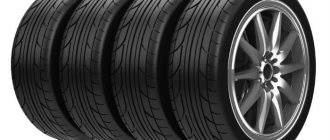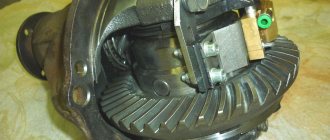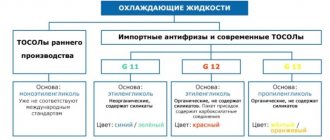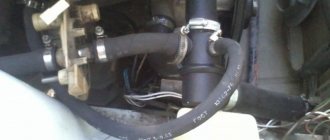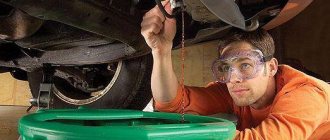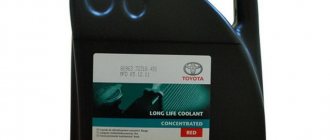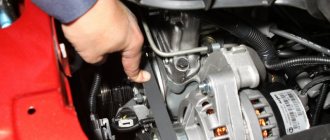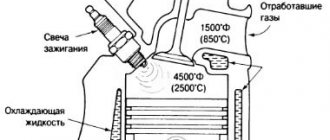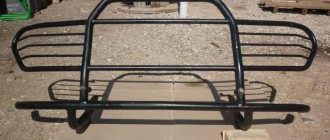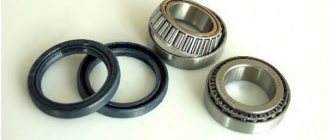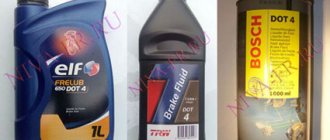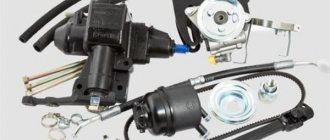Video about comparing the properties of antifreeze and antifreeze
The people of Nivovodsk are terrible and merciless in their directness of request on the Internet - Niva antifreeze. Brief, angry and understandable)) I’ll make a small disclaimer, this article is common not only for the Chevrolet Niva and Niva, but also for 90% of the existing vehicle fleet. Of course, some manufacturers have their own special recommendations (Honda perhaps distinguished itself here), but most automakers have the same requirements for antifreeze.
And of course, you need to understand that neither AvtoVAZ, nor Mercedes, nor Toyota produce their own coolants. They are made by third party chemical companies. Sometimes these companies are manufacturers of oils, such as Elf-Total or Neste.
Bleeding the hydraulic clutch and replacing the fluid of a Niva Chevrolet
If, when the pedal is pressed all the way, the clutch does not disengage completely (“drives”), which is accompanied by a characteristic grinding of gears when engaging reverse gear, there may be air in the clutch hydraulic drive. Remove it by bleeding the drive. In addition, pumping is performed when the hydraulic drive is filled with fluid after its replacement or after repair of system components associated with its depressurization.
You will need: an “8” wrench, a bleeder hose, a container for brake fluid, brake fluid.
Carry out the work with an assistant in the inspection ditch.
The supply of hydraulic clutch brake fluid is located in the reservoir located on the left side of the front panel.
With the cap installed, the brake fluid level in the reservoir should reach the lower edge of the filler neck.
With the reservoir cap removed, the liquid level should reach the upper edge of the reservoir clamp.
An increase in the fluid level in the clutch hydraulic reservoir indirectly indicates (with a sealed hydraulic drive) significant wear on the clutch driven disc linings.
To add brake fluid to the reservoir, turn it counterclockwise and remove the reservoir cap.
Add DOT-4 fluid into the tank to the required level.
Replace the lid, screwing it tightly.
If brake fluid gets on your car's paintwork, plastic parts, or wiring, it can cause damage. Remove it immediately with a clean cloth.
Bleeding the clutch hydraulic drive, replacing vehicle fluid
We pump the clutch hydraulic drive to remove air from it after it is depressurized when replacing the master cylinder, slave cylinder, hoses, tubes, as well as in case of replacing the working fluid.
We remove air from the hydraulic drive when the engine is not running.
Before pumping, check the fluid level in the clutch hydraulic reservoir and add fluid if necessary. We bleed the hydraulic drive with an assistant.
Remove the protective cap 1 from the bleeder fitting 2 of the working cylinder (Fig. 4).
Using an 8-mm spanner, loosen the tightening of the bleeder fitting. We put a hose on the fitting, and immerse its free end in a container partially filled with working fluid.
Using the “8” wrench, unscrew the bleeder fitting 1/2-3/4 of a turn.
The assistant sharply presses and smoothly releases the clutch pedal several times until the air bubbles coming out of the hose disappear. In this case, it is necessary to monitor the fluid level in the tank and top it up. With the clutch pedal pressed, tighten the bleeder fitting.
We remove the hose, wipe the bleeder fitting dry and put a protective cap on it.
If air cannot be removed, check the tightness of connections, pipelines, hoses, master and working cylinders. We tighten leaking connections, replace faulty master and working cylinders.
We replace the working fluid in the clutch hydraulic drive in accordance with the maintenance regulations - after three years.
When replacing, pump out the old fluid from the tank with a syringe or rubber bulb.
Fill the reservoir with new fluid.
We pump the clutch hydraulic drive until new fluid (lighter than the old one) begins to come out of the slave cylinder bleeder fitting.
After pumping, bring the fluid level in the clutch hydraulic reservoir to normal.
Replacing coolant Niva Chevrolet
| When should you change the coolant? — According to the manufacturer’s recommendation, the coolant should be replaced after two years of operation or after 60 thousand km, whichever comes first. In addition, if the coolant changes color to a reddish color, replace it immediately, as such a change indicates that inhibitory additives have developed and the liquid has become aggressive towards the parts of the cooling system. |
What coolant should I fill?
— Coolant recommended by the manufacturer: Antifreeze based on ethylene glycol with a complex of corrosion inhibitors and a defoamer; TOSOL TS-40 (Tosol-Sintez LLC, Dzerzhinsk) (more recommended coolants)
How much coolant should I fill?
— Capacity of the cooling system, including the interior heating system — 8 liters.
| You will need: a “13” key, coolant, a clean rag, a container for drained coolant with a capacity of at least 10 liters. |
|
Replacing antifreeze VAZ 21214
Replacing the coolant is a regulated maintenance procedure, which is prescribed in the operating instructions. There is nothing complicated about it if you clearly and carefully follow the described action plan.
Suitable for Niva cars:
- VAZ 21214
- VAZ 21213
- VAZ 2121
- VAZ 2131
Before you start replacing the coolant, to avoid getting burned, you need to wait until the engine has completely cooled down. You should also avoid getting antifreeze or antifreeze on the skin, eyes or digestive organs, since the chemical composition of the liquids is toxic.
Coolant drain
Before starting the draining procedure, you should prepare tools, containers for used antifreeze, as well as new liquids for subsequent refilling. If protection is installed under the engine, it can also be removed for convenience.
Next, we perform the procedure for draining the liquid from the VAZ 21214 (Niva):
- turn the temperature regulator in the cabin to the maximum position to the right (Fig. 1);
- place a drain container under the radiator;
- we find the plug in the bottom left corner of the radiator and unscrew it (Fig. 2);
- We put a hose on the drain neck with an internal size of 16 mm and lower it into the drain container. This will prevent antifreeze from splashing;
- after that, unscrew the plug on the radiator filler neck to drain the liquid faster (Fig. 3);
- unscrew the fastening of the expansion tank and lift it up (Fig. 4). In this case, the liquid will drain through the radiator drain hole. And the tank itself can be completely removed and washed;
- To drain the coolant from the engine, you need to unscrew the drain bolt using a 13mm wrench. The bolt itself is located on the left side (Fig. 5).
After completing this operation, do not forget to put the expansion tank in place and also tighten all the drain plugs.
Flushing the cooling system
If there are deposits in the drained liquid or there is a transition from antifreeze to antifreeze, the system should be flushed. To do this you need to do the following:
- Flush the system with plain water through the expansion tank of the VAZ 21214. The plugs must be open;
- tighten the drain plug and bolt;
- fill the system with a flushing agent (you can use Liqui Moly Kuhlerreiniger or Lavr cooling system flush) with distilled water (6-7 liters);
- start the engine. Warm up to 90 degrees;
- leave it idling for 5-10 minutes, depending on the contamination of the system;
- muffle it. Allow the engine to cool to approximately 60 degrees;
- drain the flush using the same steps as removing the old fluid;
- tighten both plugs;
- fill with distilled water to rinse the cooling system;
- start the car and warm up to 90 degrees;
- turn off and let cool to 60 degrees, drain;
- repeat steps 8, 9, 10 and 11 if necessary.
Filling antifreeze into Niva 21214, 21213 without air locks
To fill new fluid into the cooling system, you can use the instructions described in the book on car repair and operation. But when doing this, motorists very often end up with air jams.
Air locks can cause the engine to overheat and boil. And also the heating stove in VAZ 21214, VAZ 21213 (Niva) may not work.
So, let's start filling it correctly:
- before filling, unscrew the hoses supplying antifreeze to the throttle valve heating unit and lift them slightly up (Fig. 1);
- remove the plug from the filler neck of the radiator and begin to fill in antifreeze until it is completely filled (Fig. 2);
- after this, we begin to expel air from the upper radiator pipe (Fig. 3). By pressing and pulling it with your hand towards the filler neck. When performing this procedure, air bubbles should appear in the neck;
- we twist something like a funnel out of a plastic bottle and insert it into one of the pipes (Fig. 4);
- We begin filling through the funnel until the liquid reaches the upper edge of the radiator filler neck. Screw the lid on it tightly;
- After this, we continue filling through the funnel until antifreeze flows from the second pipe. We put both pipes in place and tighten the clamps (Fig. 5);
- pour antifreeze into the expansion tank a few centimeters above the MIN mark;
- We start the car, warm it up to operating temperature, let it run for 5 minutes, then turn it off.
The filling of the liquid is completed, all that remains is to wipe off the spilled antifreeze and wait for the engine to cool. With the car now cooled down, check the level in the expansion tank again and top up if necessary.
Chevrolet Niva
We pour liquid into the engine cooling system through the expansion tank until liquid flows from the coolant supply hose to the throttle body.
We pour liquid into the engine cooling system through the expansion tank until liquid flows from the coolant supply hose to the throttle body.
After this, install the hose in place and secure it with a clamp. We wrap the cap of the expansion tank. Let's start the engine. When the engine warms up, the radiator outlet (lower) hose should be cold for some time, and then quickly heat up, which will indicate the beginning of fluid circulation in a large circle. After waiting for the cooling system fan to turn on, stop the engine.
Why change the coolant on a Chevrolet Niva?
It is required to systematically monitor the level of antifreeze that is in the expansion tank. Due to the fact that the coolant is in a transparent container, it is easy to find out what level the coolant is at the moment. In normal condition, antifreeze should be on the indicator between the minimum and maximum designations. If the coolant is in a heated state, then the antifreeze level should correspond to the maximum, and in the opposite situation - to the minimum.
The owner of a Chevrolet Niva vehicle must replace the coolant according to the frequency established by the manufacturer, which is 40 thousand kilometers. In addition, it should be noted that antifreeze can be replaced every two years if the car owner rarely uses the car. At the same time, it is necessary to regularly check the coolant level and replace it if a brown tint or darkening appears. Antifreeze should also be replaced if its composition does not meet the required density, or if it is necessary to repair the engine or elements of the cooling system of a Chevrolet Niva car.
The required volume of coolant to be filled should be 10 liters. It is recommended to fill with antifreeze, which is specified in the manual for using a Chevrolet Niva vehicle.
It should be noted that there are certain signs that can help the owner of a Chevrolet Niva vehicle determine that he needs to replace the antifreeze.
Replacing the coolant is necessary in the following cases:
- The heater of a Chevrolet Niva car has stopped working well. In a situation where the vehicle’s heater begins to function poorly, the car owner is recommended to check the condition of the antifreeze and, if necessary, replace it;
- If a foam emulsion has formed in the expansion tank containing antifreeze. The designated container is located in the engine compartment of the Chevrolet Niva vehicle. If the refrigerant loses the properties it needs to function optimally, a chemical reaction occurs that causes foam to accumulate in the system;
- The engine of a Chevrolet Niva car periodically heats up. In a situation where antifreeze loses the properties it needs for optimal functioning, the vehicle engine begins to overheat. If the car owner notices this, he should definitely check the condition of the antifreeze and, if necessary, replace it;
- If sediment has formed in the expansion tank, which is located in the engine compartment of a Chevrolet Niva vehicle. The result of the loss of the physical properties of antifreeze is a chemical reaction, after which a sediment forms in the coolant reservoir.
In addition to the information indicated, it should be clarified that if the owner of the vehicle repairs the heater, radiator, or cylinder head, then reusing antifreeze is prohibited.
antifreeze or antifreeze? - Rutvet magazine
- What antifreeze should I put in a Chevrolet Niva?
- Replacing antifreeze with antifreeze on a Chevrolet Niva
- Start draining liquid
- Filling with new coolant
It is necessary to fill the Chevrolet Niva with antifreeze, strictly observing the established frequency. It is assigned by the manufacturer and amounts to one fill per 40 thousand kilometers. In exceptional cases, if the driver uses the vehicle little, antifreeze can be added once every couple of years.
It should be borne in mind that the volume of antifreeze should be regularly checked and urgently changed if a brownish tint or dark color of the liquid is detected. In addition, replacement of technical fluid is necessary if it does not meet the established density values or the engine requires major overhaul.
What antifreeze should I put in a Chevrolet Niva?
Many car enthusiasts are interested in the question: what antifreeze is best to fill in a Chevrolet Niva? When choosing the right composition, the car enthusiast will need to rely on the advice provided by the manufacturer and on his own experience in operating and maintaining these cars.
The most suitable options are listed below:
- Vehicles manufactured in 2002 can be operated with red liquid of category G12. It's best to go with G-Energy.
- Cars produced in the range of 2003-2009 are suitable for category G12 red antifreeze. Options include Lukoil Ultra, Havoline, G-Energy and others.
- Since 2010, Chevrolet Niva works well on red antifreeze of the G12 ++ class, including the brands VAG, Freecor QR, and FEBI.
How much antifreeze is required for a Chevrolet Niva? In order to fill the cooling system of a car, approximately 10 liters of working fluid are required.
Replacing antifreeze with antifreeze on a Chevrolet Niva
In order to change antifreeze on a Chevrolet Niva, you will need to find an inspection hole. In addition, it is allowed to use an overpass. Make sure that the vehicle is parked on a straight, horizontal surface. The car needs to be fixed to avoid its displacement during the procedure. If it is not possible to find a flat surface, it is recommended to find an area where the front of the car will be slightly tilted up.
Before you start replacing antifreeze, it is important to take the time to remove the negative voltage from the battery, prepare a set of tools and wait until the power unit cools down. You will need to have with you a “tenth” spanner, a funnel to fill in the technical fluid, a regular screwdriver, a container where the old fluid will be drained, pliers, as well as the required volume of new antifreeze.
Start draining liquid
To do this you will need to do the following:
- The hood must be raised and firmly secured in this position.
- Unscrew the cap of the expansion tank. You should not rush into this - heated air must come out of the tank, then the pressure inside will decrease. The cover is then removed completely.
- The plug is unscrewed from the drain hole. The working fluid should come out. It is advisable to place a container nearby in advance so that all the used antifreeze from the Chevrolet Niva goes there and not on the ground.
To avoid air plugs in the system, you will need to discard the plug tube from the throttle assembly. To do this, it is necessary to use a screwdriver to loosen the fastener, and the latter subsequently moves posteriorly. This allows such a procedure to be carried out.
Filling with new coolant
The next step is to fill the cooling system with a new volume of technical fluid. Here, many car enthusiasts have a question: what kind of coolant is poured into a Chevrolet Niva: antifreeze or antifreeze? In reality, despite the fact that car owners are accustomed to distinguishing antifreeze from antifreeze, these two liquids are not different coolants. Antifreeze is the name of Russian antifreeze.
Watch a video about replacing the coolant on a Niva Chevrolet.
What will need to be done to replace the old antifreeze with antifreeze in a Chevrolet Niva:
- New working fluid is placed in the cooling system reservoir.
- It is necessary to monitor the antifreeze level. When coolant flows out of the throttle assembly outlet, the hose should be returned to its original position and secured with a clamp.
- The cooling system needs to be filled. The fluid level should not exceed the Max mark.
- When pouring antifreeze, the car owner should regularly press lightly on the radiator tubes to prevent the development of air locks.
- When the cooling system is completely filled, the cap of the expansion tank must be screwed back on.
Read about how to start a diesel engine in cold weather. And also about how to remove bitumen from a car.
This ends the main part related to filling a new volume of technical coolant. Now the car owner will be required to start the engine of his vehicle and leave it running for a while until the fan is started. After it works, you need to check the temperature of the air that will exit the heater.
If it is cool, this indicates air pockets. To eliminate them, you need to unscrew the radiator cap, start the engine again and leave it for 4-6 minutes. Then the power unit can be turned off and the radiator cap screwed back on.
When the second circle in the cooling system opens, the total volume of coolant decreases. It is necessary to wait until the engine cools down again, and then top up the missing part, if necessary. After a couple of days of using the vehicle, it is important to check the coolant level again and check the shade of antifreeze, which will help determine what kind of antifreeze is used in the Chevrolet Niva. If the liquid takes on a reddish tone, this means that a fake is being used.
In addition, you will need to prevent antifreeze from leaking from the Chevrolet Niva after replacing it. In the first days after changing the coolant, you need to pay attention to any wet spots under the vehicle and to collecting drops of liquid. Usually it is possible to determine the location of the leak visually, but if this is not possible, you will need to check each element of the cooling unit.
What are you planning to put in your car? Leave your message in the comments! And also watch a video about replacing antifreeze with antifreeze in a Chevrolet Niva.
www.rutvet.ru
Replacement process
To replace antifreeze on a Niva Chevrolet, find an inspection hole. You can also work on an overpass or lift
It is important that the car stands strictly horizontally, with mandatory fixation, in order to avoid movement during the work process. If you can't find a perfectly level area, find an area where the front of the machine is slightly higher
Before draining the antifreeze, perform a few more manipulations - wait until the engine cools down, remove the negative voltage from the battery, and also prepare the tool for work. You will need a ten-socket wrench, a funnel for filling coolant, pliers, a screwdriver, a new portion of antifreeze and a container for draining the coolant. Use a canister, bucket, basin or bottle as a drainage container.
Antifreeze Frostschutzmittel A from Febi Let's start with how to drain the antifreeze. Take a series of steps:
Open and secure the hood. Unscrew the cap on the expansion tank. As noted above, wait until the engine cools down to avoid burning your hands. As a last resort, the coolant temperature should not exceed 90 degrees Celsius
Carefully unscrew the cap, take your time. Allow hot air to escape, which reduces pressure
After this, unscrew the cap completely. Unscrew the plug from the drain hole, and then wait until all the coolant comes out. Don't forget to place the container first to avoid getting antifreeze on the ground. As soon as the waste fluid leaves the system, screw the plug back into place.
To avoid air locks in the system, discard the tube from the fitting of the throttle assembly. To do this, take a screwdriver or pliers, and then, using the tool, loosen the fastener, and then move it back. Now remove the tube from the throttle body fitting.
Filling with new antifreeze Above we looked at the first stage - how to drain the antifreeze. The next step is to fill the system with new coolant. Remember that the composition must be prepared, because many antifreezes are sold as a concentrate and require dilution with distilled water, in a ratio of 1 to 1. Read the instructions carefully, because they may contain other information.
Next, do the following:
- Pour new antifreeze into the reservoir.
- Monitor the working fluid level. As soon as it comes out of the throttle assembly, return the hose to its place and install the clamp.
- Fill the cooling system. The antifreeze level should reach the MAX line.
- During the filling process, press the radiator tubes several times to prevent plugs from forming.
- After filling the cooling system, screw the cap on the expansion tank.
Bi-xenon or LEDs, which is better The main process of replacing antifreeze is completed. Now start the Chevrolet Niva engine and leave it running until the fan starts. After the last one is triggered, check what kind of air comes out of the heater. If there is a cold flow, this indicates the presence of air pockets. In such a situation, open the cap on the radiator, start the engine and let it run for 5 minutes. Afterwards, turn off the engine and close the cap on the radiator.
After opening the second circle in the cooling system, the antifreeze level decreases. Wait until the engine cools down, then top up to the required volume (if required)
After 2-3 days of operation, check the coolant level again, and also pay attention to the color of the antifreeze
If it has a reddish tint, it means the system is filled with a fake. In such a situation, the coolant needs to be changed. If you need to get rid of air jams, the principle will be the same as described above.
Replacing antifreeze in Niva Chevrolet cars is possible even for novice car owners. To solve the problem, it is not at all necessary to go to a service station, because all the work can be done with your own hands. Video: How to drain antifreeze on a Chevrolet Niva in 15 minutes!
If the video doesn't show, refresh the page or click here. Prudent car owners make sure their car runs smoothly. All systems must be normal: power, ignition, cooling and lubrication. During operation, a large amount of heat is released from the motor. To prevent it from overheating, it is necessary to maintain the recommended temperature. This function is performed by a special coolant (coolant).
Replacement instructions
The procedure for replacing the coolant is not complicated, so even a novice car enthusiast can perform it.
How much to pour?
Antifreeze in a car, according to the manufacturer’s recommendations, should be changed after 40 thousand kilometers or after two years of operation. In this case, it is necessary to constantly monitor the condition of the coolant and check its level. If it has darkened or become cinnamon in color, then it needs to be changed. If the level is below the required level, add water or antifreeze. Replacement may be required if the coolant poured into the car does not meet the density.
The required volume of liquid to be filled is 10 liters. It is advisable to fill with coolant specified in the owner's manual.
Coolant
What will you need?
To carry out the replacement, you will need an inspection hole, a lift or an overpass. The machine must be installed horizontally and secured so that it cannot roll during work. The front of the machine should be installed higher than the rear. The procedure is carried out only on a cold engine. To carry it out you need to prepare the following tools and materials:
- spanner set to “10”;
- pliers;
- screwdriver;
- funnel;
- container for draining waste liquid;
- new antifreeze;
- clean rag.
A watering can can be made from a plastic bottle by cutting it in half. A canister or plastic water bottle is suitable as a container.
Stages
Having installed the car on the inspection hole, they begin to replace the coolant.
- First, open and secure the hood.
- The next step is to unscrew the cap on the expansion tank. It is advisable to perform the procedure on a cold machine.
Expansion tank Niva Chevrolet
If this is not possible, then the coolant temperature should be no higher than 90 degrees. To avoid getting burned by steam or hot liquid, place a rag on the engine and around the neck of the expansion tank. The lid should be unscrewed carefully. First you need to unscrew it a little so that hot air comes out and release the tank from pressure, and then unscrew it completely. - Now unscrew the plug on the drain hole and drain all the liquid. When the used antifreeze has drained, screw the plug back into place.
- To prevent the formation of air plugs in the cooling system, you need to disconnect the hose from the throttle body fitting. To do this, use a screwdriver or pliers to loosen the fastening on the clamp and move it back. Then disconnect the hose from the throttle assembly fitting.
- Before adding coolant, it should be prepared. There are ready-to-use liquids, mainly antifreeze. There are antifreezes that require dilution with distilled water; usually the proportion is 50/50, unless otherwise indicated in the instructions.
- Next, you can proceed to filling the cooling system.
Fill with antifreeze.
The coolant is poured into the expansion tank. As soon as it begins to flow out of the throttle body nozzle, put the hose on the nozzle and tighten the hose clamp. Next, continue to fill the antifreeze solution to the maximum mark in the expansion tank. - When pouring antifreeze solution, tighten the radiator hoses to prevent air pockets from forming.
- After the cooling system is filled, tighten the cap on the expansion tank.
- Next, you need to start the engine and wait for the electric fan to turn on. If this does not happen, you need to check what kind of air is coming from the heater. If it is warm, then the fan is faulty, if it is cold, the reason is the presence of air pockets formed in the system. To get rid of them, you need to open the cap on the radiator, start the engine, and after 5 minutes of operation, turn off the engine. Now close the radiator cap.
Removing the radiator cap - When the second cooling circle opens, the coolant level will drop significantly.
- You must wait until the engine cools down. Next, check the fluid level again. On a cold engine it should be between maximum and minimum, on a hot engine it should be at maximum. If necessary, add to the required volume.
Loading …
When several days have passed after the replacement, you need to check the fluid level and get rid of possible air pockets. The process of getting rid of air pockets is the same as when replacing antifreeze: remove the cap on the radiator, let the engine run for a few minutes, close the radiator. You should also pay attention to the color of the antifreeze, if it has changed: it has darkened, become reddish, most likely a fake has been filled in, in which case the coolant needs to be replaced.
Prevention measures
A huge portion of breakdowns can be avoided if you treat your own car accordingly. Yes, no one excludes unforeseen situations, but simple preventive measures should definitely become the norm for you when handling your car:
- Constantly check the coolant level in the reservoir and top up if necessary;
- For your VAZ 2110, do not skimp on high-quality coolant;
- Do not use plain water as a coolant, as it has a lower boiling point and promotes scale formation and corrosion inside the cooling system;
- Always look at the readings of the coolant temperature sensor located in the cabin. Avoid situations where the arrow crosses the red line.
It is obvious that the CO is the most important unit in the engine compartment, the efficiency of which determines the condition, performance of the engine and more.
Therefore, it is extremely important to treat the cooling system with care, monitor its condition, and take timely actions to eliminate any malfunctions that arise. Sometimes on the highway you see the following picture: a passenger car is standing with the hood raised, steam is rising from the engine compartment, and a motorist is running around the vehicle. , sometimes the car passengers are with him.
Sometimes on the highway you see the following picture: a passenger car is standing with the hood raised, steam is rising from the engine compartment, and a car enthusiast is running around the vehicle, sometimes the passengers of the car along with him.
The situation is, in fact, quite banal in its essence. There can only be two reasons - the engine temperature sensor in the vehicle has failed, or the driver has overlooked a sharp increase in its temperature. As a result, the engine overheated, the coolant exceeded the boiling point and turned into steam, the driver opened the radiator cap to reduce the temperature, and steam began to escape under pressure through this hole. This is also fraught with the risk of getting burns if an inexperienced car enthusiast opens the radiator cap carelessly.
How to prevent the possibility of such a situation occurring? The first thing is to be careful while driving and observe the instrument readings, as well as monitor the condition of the VAZ 2110 temperature sensor so that it does not fail.
RECOMMENDED TEMPERATURE RANGES FOR APPLICATION OF MOTOR OILS
Table 3
| Minimum engine cold start temperature, 0C | Viscosity grade according to SAE J 300 | Maximum ambient temperature, 0C |
| below -35 | 0W-30 | 25 |
| below -35 | 0W-40 | 30 |
| -30 | 5W-30 | 25 |
| -30 | 5W-40 | 35 |
| -25 | 10W-30 | 25 |
| -25 | 10W-40 | 35 |
| -20 | 15W-40 | 45 |
| -15 | 20W-40 | 45 |
How to choose coolant?
The selection of coolant should be approached responsibly.
Making a choice right away is not so easy. Today, stores offer a large selection of canisters and bottles of various colors and compositions. The question is brewing: what to fill - antifreeze or antifreeze? What does the manufacturer recommend?
Types and properties of coolants for cars
The best option for effectively lowering the temperature is antifreeze. This is a liquid that contains:
- distilled water;
- ethylene glycol or propylene glycol (less aggressive substance);
- additional additives.
Distilled water. Ethylene glycol based antifreeze.
Additives, in turn, are divided into the following subtypes:
- silicate;
- based on organic acids (carboxylate);
- hybrid antifreezes (based on the two described above).
Carboxylate coolants have good heat transfer and high cooling temperatures. They reliably fight fat deposits and have a longer service life. Silicate antifreezes perfectly prevent corrosion and reduce the temperature of aqueous solutions. They are considered universal.
>
Carboxylate coolant after 60,000 km
Depending on the additives used, a high-quality coolant must have a high boiling point and thermal conductivity. Also not to be exposed to freezing in the winter season, maintaining its performance. Do not form scale or foam.
What kind of coolant is filled in the Chevrolet Niva from the factory? – Taxi Bolt
Prudent car owners ensure that their car runs smoothly. All systems must be normal: power, ignition, cooling and lubrication. During operation, a large amount of heat is released from the motor.
To prevent it from overheating, it is necessary to maintain the recommended temperature. This function is performed by a special coolant (coolant).
How to choose coolant?
The selection of coolant should be approached responsibly. Making a choice right away is not so easy. Today, stores offer a large selection of canisters and bottles of various colors and compositions.
The question is brewing: what to fill - antifreeze or antifreeze? What does the manufacturer recommend?
Types and properties of coolants for cars
The best option for effectively lowering the temperature is antifreeze. This is a liquid that contains :
- distilled water;
- ethylene glycol or propylene glycol (less aggressive substance);
- additional additives.
Antifreeze based on ethylene glycol. Additives, in turn, are divided into the following subtypes:
- silicate;
- based on organic acids (carboxylate);
- hybrid antifreezes (based on the two described above).
Carboxylate coolants have good heat transfer and high cooling temperatures . They reliably fight fat deposits and have a longer service life. Silicate antifreezes perfectly prevent corrosion and reduce the temperature of aqueous solutions. They are considered universal.
Carboxylate coolant after 60,000 km.
Depending on the additives used, a high-quality coolant must have a high boiling point and thermal conductivity. Also not to be exposed to freezing in the winter season, maintaining its performance. Do not form scale or foam.
What coolant is recommended for the Niva Chevrolet car
In general, both G12 type antifreeze and antifreeze are suitable for the car .
Many car owners mistakenly claim that antifreeze is a cheap and lower quality version of antifreeze. Modern antifreeze manufacturing technologies make it possible to compete not only with domestic, but also with foreign coolant manufacturers. The only significant difference is the shorter service life of antifreeze compared to antifreeze.
In the Chevrolet Niva, coolant replacement is done as standard - once every 2 years, or every 60 thousand km . Another factor indicating the need to change the coolant is a change in its color. It acquires a reddish tint, which indicates a change in chemical properties.
https://www.youtube.com/watch?v=7WwNaWrBJsI
On cars with air conditioning, it is better to use G12 antifreeze . Usually the plant fills it with TOSOL TS-40 (manufacturer: Dzerzhinsk). Mixing different types of coolant is prohibited. An exception for topping up is FelixProLonger liquid (from the same manufacturer).
on comparing the properties of antifreeze and antifreeze
Replacing antifreeze on a Niva Chevrolet car must be carried out taking into account the strict frequency established by the manufacturer - once every 40,000 km, or (if the car owner rarely uses the car) every two years. At the same time, it is necessary to check the antifreeze level and replace it if it darkens or appears brown. Also, replacement of antifreeze may be necessary if the composition does not meet the required density or repair of the engine (cooling system elements) is required.
Antifreeze Niva, basic practical issues
Answer: AvtoTAZ poured blue-green antifreeze for a very long time. But since 2012, almost every car I've seen has been a red G12. But there are still batches of cars filled with antifreeze.
What can be added and what can be mixed?
Answer: G11 and G12 cannot be mixed. Translated into Russian, blue-green and red-orange cannot be mixed.
- How to competently switch to G12? If you simply drain G11 and fill in G12, there will be no benefit except wasted money. The result will only be obtained after a “chemical” cleaning of the cooling system.
- Why do you recommend replacing “blue” with “red”. And so everyone works well. True, I have already changed several thermostats.
Answer: According to German articles on cooling, one of the reasons for thermostat failure is precisely low-quality antifreeze. We are talking about the film that jams the thermostat valve.
“Red” antifreeze is filled in, but for some reason when the engine heats up, it expands very much (can be seen from the level in the expansion tank).
Answer: it was filled with low-grade body slurry. When heated, water increases in volume up to 8-10%, antifreeze within 1%.
Antifreeze Niva, concentrate or ready-made?
Answer: Now I supply ready-made antifreeze, but we have a large country, so in a number of regions antifreeze with a crystallization temperature of minus 40 and below is required. Then you need to order the concentrate and dilute it according to your operating conditions.
The next question follows from the previous one and it usually comes from Yakutsk, Irkutsk, the Yamal Peninsula and other “resort” places in our homeland. What are the ratios for greater frosts than minus 40?
Answer: I provide data from Neste documentation. 50% -50% (water-concentrate ratio) – pour point minus forty.
40% water - 60% conc. freezing threshold minus 50 degrees. 25% water - 75% conc.
the freezing threshold is minus 65-70 degrees. But don’t get carried away. The freezing threshold increases, but other characteristics worsen.
What antifreeze do you use and complete orders?
Answer: I prefer the products of the Elf-Total concern and the antifreeze of our northern neighbors, the Finns. Manufacturer: Neste. This is if we talk about applicability to the Niva and UAZ family.
Antifreeze Niva, how much do you need to replace?
Answer: There are about 8 liters of coolant in the system. It can be drained as much as possible if you park the car on a slope, with the left side at the bottom. When the plugs on the block and radiator are open, almost everything drains. The quantity in Niva and Shnivy is the same.
Antifreeze Niva. A little history. What is antifreeze.
The people of Nivovodsk are terrible and merciless in their directness of request on the Internet - Niva antifreeze. Brief, angry and understandable)) I’ll make a small disclaimer, this article is common not only for the Chevrolet Niva and Niva, but also for 90% of the existing vehicle fleet. Of course, some manufacturers have their own special recommendations (Honda perhaps distinguished itself here), but most automakers have the same requirements for antifreeze. And of course, you need to understand that neither AvtoVAZ, nor Mercedes, nor Toyota produce their own coolants. They are made by third party chemical companies. Sometimes these companies are manufacturers of oils, such as Elf-Total or Neste. And sometimes these are pure “chemists”, for example the Basf concern.
A drop of history
I’ll try to very briefly outline the situation, what happens in general and what specifically applies to our cars. What is antifreeze and what is ANTIFREEZE. When the Italians came to the USSR to adapt cars and engines for the 2101, they didn’t like a lot of things. In particular, the quality of gasoline and coolants. Then Soviet chemists developed TOSOL. I decipher it - Technology of Organic Synthesis of OL (designation of alcohols, according to some state standards). So, TOSOL is one of the cheap antifreezes.
Problem
Every second letter contains a question and a request: explain why I do not recommend a domestic product. After all, unlike oils, Niva antifreeze is a fairly simple thing. There are two reasons.
- At one time it was customary to criticize GOST standards. Now we will break everything, there will be competition and it will be good. It turned out to be bad)) The only regulatory act that exists today is GOST 28084–89, which was adopted during the Soviet era. And even today it is quite outdated, even for the domestic automobile industry. But in our country we have such magical standards, which are called TU (technical conditions). And for each area they are different. That is, the military has its own specifications for tank coolant. And the Ministry of Agriculture has its own specifications - for the ZIL-130 car. Can you imagine what a riot this is for imagination?? And most importantly, the manufacturer does not deceive you)))
- I am a bad chemist, to be more honest - very bad, and to be completely honest - then none at all)) Therefore, this paragraph was written under the dictation of a professor at the St. Petersburg Institute of Technology)) Ethylene glycol is a fairly expensive product, so our Papuans replace it with cheap bodyagi, consisting of glycerol and methanol. And if the first component is very harmful to the cooling system, then the second is simply incompatible with human health. And the methyl compound with water at temperatures above 50-60 degrees begins to “gnaw” aluminum. In chemistry, this term is called “etching.” And one more funny moment. Methanol evaporates when heated, the client adds water. So the process is repeated several times. As a result, the system simply produces colored water, which will freeze at the first frost.
Classification (VAG concern)
The most popular classification is the Volkswagen-Audi tolerance system. Now they have changed the designations, but everyone basically writes these “mysterious symbols” on the cans.
G11 – ethylene glycol base, the cheapest coolant, with a small package of additives. Usually blue-green in color. Russian analogue of "Tosol". Action: covers ALL walls of the cooling system with a thin film, which should protect against corrosion. The disadvantage is that this film is a very good thermal insulator and quite significantly reduces the efficiency of the cooling system. Recommended service life is 2 years (data taken from the German directory). One year of operation in Germany is equivalent to 20 thousand km, but whether the car was parked or driven does not matter.
G12 – base ethylene glycol, additives – carboxylate compounds. Usually red. It acts locally on areas of corrosion and for this reason has significantly better heat removal. Long-playing. Service life without loss of characteristics is more than 5 years. G12+ - polypropylene glycol base. The color is usually orange. Made for the sake of the environment. Non-toxic, can decompose naturally in nature. The boiling point of this antifreeze is increased to 135 degrees.
Neste antifreeze, concentrate
Freezing and crystallization. What is it and what is the difference. According to our GOSTs there is no difference, but according to Western standards there is. Crystallization temperature is the state at which crystals begin to form in a liquid. Ice slush forms. The freezing point is the point at which antifreeze becomes a “solid state.” It does not harden like ice, but rather looks like cooled semolina or oatmeal (whoever liked which one more in kindergarten). For the antifreeze I presented in this article, the crystallization temperature is minus 35, the pour point is minus 42.
ready antifreeze Total
Antifreeze Niva, basic practical issues
- What is AvtoVAZ pouring into our cars now?
Answer: AvtoTAZ poured blue-green antifreeze for a very long time. But since 2012, almost every car I've seen has been a red G12. But there are still batches of cars filled with antifreeze.
- What can be added and what can be mixed?
Answer: G11 and G12 cannot be mixed. Translated into Russian, blue-green and red-orange cannot be mixed.
- How to competently switch to G12? If you simply drain G11 and fill in G12, there will be no benefit except wasted money. The result will only be obtained after a “chemical” cleaning of the cooling system.
- Why do you recommend replacing “blue” with “red”. And so everyone works well. True, I have already changed several thermostats.
Answer: According to German articles on cooling, one of the reasons for thermostat failure is precisely low-quality antifreeze. We are talking about the film that jams the thermostat valve.
- “Red” antifreeze is filled in, but for some reason when the engine heats up, it expands very much (can be seen from the level in the expansion tank).
Answer: it was filled with low-grade body slurry. When heated, water increases in volume up to 8-10%, antifreeze within 1%.
- Antifreeze Niva, concentrate or ready-made?
Answer: Now I supply ready-made antifreeze, but we have a large country, so in a number of regions antifreeze with a crystallization temperature of minus 40 and below is required. Then you need to order the concentrate and dilute it according to your operating conditions.
- The next question follows from the previous one and it usually comes from Yakutsk, Irkutsk, the Yamal Peninsula and other “resort” places in our homeland. What are the ratios for greater frosts than minus 40?
Answer: I provide data from Neste documentation.
50% -50% (water-concentrate ratio) – pour point minus forty.
40% water - 60% conc. freezing threshold minus 50 degrees.
25% water - 75% conc. freezing threshold minus 65-70 degrees
But don't get carried away. The freezing threshold increases, but other characteristics worsen.
- What antifreeze do you use and complete orders?
Answer: I prefer the products of the Elf-Total concern and the antifreeze of our northern neighbors, the Finns. Manufacturer: Neste. This is if we talk about applicability to the Niva and UAZ family.
- Antifreeze Niva, how much do you need to replace?
Answer: There are about 8 liters of coolant in the system. It can be drained as much as possible if you park the car on a slope, with the left side at the bottom. When the plugs on the block and radiator are open, almost everything drains. The quantity in Niva and Shnivy is the same.
Did you like the article? Share with your friends!
niva-fr.ru
Replacing antifreeze with antifreeze on a Chevrolet Niva
In order to change antifreeze on a Chevrolet Niva, you will need to find an inspection hole. In addition, it is allowed to use an overpass. Make sure that the vehicle is parked on a straight, horizontal surface. The car needs to be fixed to avoid its displacement during the procedure. If it is not possible to find a flat surface, it is recommended to find an area where the front of the car will be slightly tilted up.
Before you start replacing antifreeze, it is important to take the time to remove the negative voltage from the battery, prepare a set of tools and wait until the power unit cools down. You will need to have with you a “tenth” spanner wrench, a funnel to fill in the technical fluid, a regular screwdriver, a container into which the old fluid will be drained, pliers, as well as the required volume of new antifreeze
Start draining liquid
To do this you will need to do the following:
- The hood must be raised and firmly secured in this position.
- Unscrew the cap of the expansion tank. You should not rush into this - heated air must come out of the tank, then the pressure inside will decrease. The cover is then removed completely.
- The plug is unscrewed from the drain hole. The working fluid should come out. It is advisable to place a container nearby in advance so that all the used antifreeze from the Chevrolet Niva goes there and not on the ground.
To avoid air plugs in the system, you will need to discard the plug tube from the throttle assembly. To do this, it is necessary to use a screwdriver to loosen the fastener, and the latter subsequently moves posteriorly. This allows such a procedure to be carried out.
Filling with new coolant
The next step is to fill the cooling system with a new volume of technical fluid. Here, many car enthusiasts have a question: what kind of coolant is poured into a Chevrolet Niva: antifreeze or antifreeze? In reality, despite the fact that car owners are accustomed to distinguishing antifreeze from antifreeze, these two liquids are not different coolants. Antifreeze is the name of Russian antifreeze.
Watch a video about replacing the coolant on a Niva Chevrolet.
What will need to be done to replace the old antifreeze with antifreeze in a Chevrolet Niva:
- New working fluid is placed in the cooling system reservoir.
- It is necessary to monitor the antifreeze level. When coolant flows out of the throttle assembly outlet, the hose should be returned to its original position and secured with a clamp.
- The cooling system needs to be filled. The fluid level should not exceed the Max mark.
- When pouring antifreeze, the car owner should regularly press lightly on the radiator tubes to prevent the development of air locks.
- When the cooling system is completely filled, the cap of the expansion tank must be screwed back on.
This ends the main part related to filling a new volume of technical coolant. Now the car owner will be required to start the engine of his vehicle and leave it running for a while until the fan is started. After it works, you need to check the temperature of the air that will exit the heater.
If it is cool, this indicates air pockets. To eliminate them, you need to unscrew the radiator cap, start the engine again and leave it for 4-6 minutes. Then the power unit can be turned off and the radiator cap screwed back on.
When the second circle in the cooling system opens, the total volume of coolant decreases. It is necessary to wait until the engine cools down again, and then top up the missing part, if necessary.
After a couple of days of using the vehicle, it is important to check the coolant level again and check the shade of antifreeze, which will help determine what kind of antifreeze is used in the Chevrolet Niva. If the liquid takes on a reddish tone, this means that a fake is being used.
In addition, you will need to prevent antifreeze from leaking from the Chevrolet Niva after replacing it
In the first days after changing the coolant, you need to pay attention to any wet spots under the vehicle and to collecting drops of liquid. Usually it is possible to determine the location of the leak visually, but if this is not possible, you will need to check each element of the cooling unit
What are you planning to put in your car? Leave your message at ! And also watch a video about replacing antifreeze with antifreeze in a Chevrolet Niva.
Stages of replacing Chevrolet Niva coolant
When switching from antifreeze to antifreeze, it is necessary to flush the cooling system. This is done so that the new liquid does not lose its properties when mixed. Also, due to the different chemical composition, a precipitate or flakes may form. Therefore, the correct procedure between draining and filling should include a flushing step.
This model is quite popular, so many people know it under other names:
- Chevrolet Niva;
- Chevy Niva;
- Shniva;
- VAZ-21236.
We will consider the instructions for replacing the coolant using the example of a 1.7-liter gasoline engine. But there is one nuance: cars after the 2020 restyling have electronic control of the gas pedal.
Accordingly, there are no pipes for heating the throttle valve. Therefore, we will consider bleeding air on this modification. You can also familiarize yourself with the nuances of replacement on a regular Niva 4x4, the replacement on which we also described.
Coolant drain
To drain the antifreeze, you need to place the car on a flat surface, open the cap of the expansion tank and wait a little until the temperature drops below 60°C. For further convenience, remove the decorative plastic protection on top of the engine.
Further in the instructions we are recommended to turn the temperature regulator to maximum. But it is useless to do this. Since the temperature control in the Chevrolet Niva occurs by moving the air damper. And not by blocking the radiator as in old VAZs.
After the machine has cooled down a little, we begin the draining process itself:
- If you stand in front of the car, at the bottom right, there is a plastic valve on the radiator that closes the drain hole. We unscrew it to drain the antifreeze from the radiator (Fig. 1). When unscrewing, be careful not to lose the rubber O-ring.
In this way, we completely drained the old fluid, but in any case, a small part still remains in the system, distributed among the engine channels. Therefore, in order for the replacement to be high-quality, we proceed to flushing the system.
